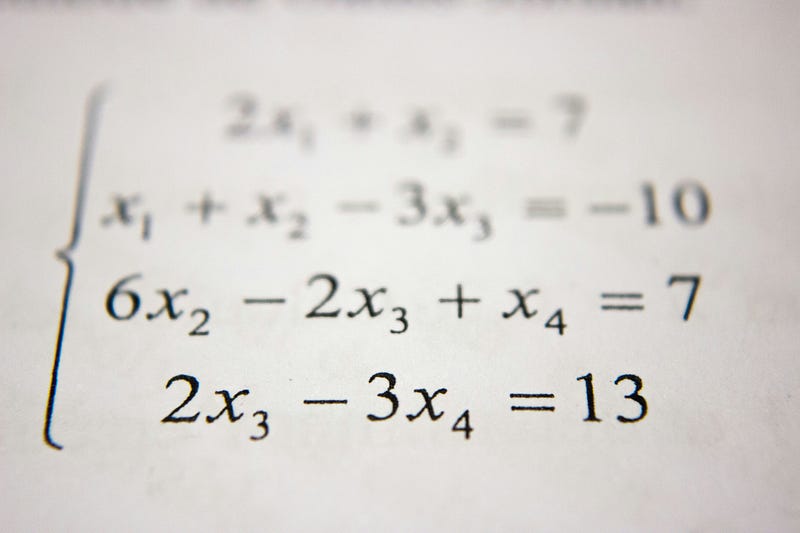The Impossibility of a Set of All Sets: A Mathematical Exploration
Written on

In the captivating realm of mathematics, sets are fundamental to the organization of numbers, objects, and concepts. However, the idea of a "set of all sets" presents a compelling paradox: it cannot exist. This contradiction, termed Russell's Paradox, emerges from the inconsistencies within set theory when one considers a set that encompasses every conceivable set, including itself. Mathematicians and philosophers have engaged deeply with this enigma, shedding light on the limitations inherent in set theory. Why is this set deemed impossible? Including itself leads to a paradoxical loop, conflicting with its own definition. By dissecting this paradox, we enhance our understanding of the logical beauty and inherent limits within mathematics.
Understanding Sets in Mathematics
Sets serve as the foundational elements in the vast landscape of mathematics. By studying sets, we explore the fundamental concept of grouping distinct entities based on shared characteristics. Whether we categorize numbers, letters, or other objects, sets facilitate structured data organization and analysis. Imagine sorting various candies into distinct jars — each jar symbolizes a set, while the candies represent the elements within.
Definition of a Set
A set in mathematical language refers to a clearly defined collection of objects, regarded as individual entities. The items within a set are termed elements or members. To avoid confusion, sets are defined precisely, ensuring clarity about their contents.
For example, consider the set of vowels in the English alphabet: {a, e, i, o, u}. The curly brackets indicate we are dealing with a set, and the letters inside are its elements. Sets can either be finite, as in our vowel example, or infinite, like the collection of all natural numbers.
For a more comprehensive exploration of sets, check out this introduction to sets.
Types of Sets
Sets are diverse, each type serving a unique function in mathematics. Here are some common categories:
- Finite Sets: These contain a limited number of elements, such as the days of the week.
- Infinite Sets: As the name implies, these sets have limitless elements, like the set of all integers.
- Subsets: A subset consists of elements that belong to another set. For example, if Set A is {1, 2, 3} and Set B is {1, 2}, then Set B is a subset of Set A.
- Power Sets: The power set of any set encompasses all possible subsets of that set. For instance, the power set of {1, 2} would be {{}, {1}, {2}, {1, 2}}.
For further information on the types of sets, you can refer to Types of Sets from GeeksforGeeks.
Grasping these various types of sets not only enriches our understanding of basic mathematics but also enhances our ability to tackle problems logically and systematically. Sets act as the unseen backbone of mathematics, essential to the entire structure of mathematical reasoning and critical in fields like algebra, calculus, and beyond.
The Concept of the Set of All Sets
The notion of a “set of all sets” is intriguing but fraught with confusion and paradoxes. Attempting to include every possible set presents a challenge that even seasoned mathematicians find perplexing. Let’s dissect this concept to better understand its implications.
What Would a Set of All Sets Include?
Imagine a colossal basket designed to hold every conceivable collection of objects. Now, picture this basket trying to contain every possible basket, including itself. What would it contain?
A set of all sets would theoretically encompass:
- Every conceivable collection of numbers, such as integers and fractions.
- Sets of shapes, ranging from triangles to n-dimensional polygons.
- Abstract concepts, including ideas, emotions, and even other sets.
- Itself, which triggers the paradox. If this set contains all sets, does it also include the set that contains itself?
Contemplating this is akin to a mirror reflecting itself endlessly — it loops infinitely. This is why mathematicians frequently invoke Russell’s Paradox when discussing this concept. Proposed by Bertrand Russell, this paradox underscores the contradictions that arise when a set includes itself while simultaneously not including itself.
Historical Context
The development of set theory can be traced back to the work of Georg Cantor in the late 19th century. Cantor's revolutionary ideas allowed mathematicians to discuss infinity in a systematic manner. His contributions laid the groundwork for discussions surrounding collections of objects.
As set theory evolved, complexities and contradictions emerged. The history of set theory illustrates how mathematicians like Russell and Zermelo grappled with the concept of the set of all sets, discovering that attempting to include every set in one enormous set resulted in illogical conclusions.
Exploring the history of this idea is akin to navigating a maze filled with unexpected twists and dead ends. Yet, it remains a captivating subject for those who enjoy contemplating profound and challenging concepts.
Russell’s Paradox: Unraveling the Contradictions of Set Theory
Russell’s Paradox is a captivating puzzle that has intrigued both mathematicians and philosophers. It raises questions about how something as fundamental as set theory could harbor such a perplexing contradiction. At its core, Russell’s Paradox illustrates why the set of all sets cannot exist, leading to significant shifts in mathematical logic's foundations.
Explanation of Russell’s Paradox
So, what precisely is Russell’s Paradox? Imagine a barber who shaves everyone in town who does not shave themselves. The question arises: does the barber shave himself? If he does, according to the rule, he should not. Conversely, if he does not shave himself, then he must shave himself by definition. This encapsulates the essence of Russell’s Paradox.
In mathematical terms, it unveils a contradiction in naive set theory, particularly regarding the idea of a “set of all sets.” The set that contains all sets not containing themselves cannot consistently exist. Learn more about the paradox in detail here.
Russell’s Paradox serves as an essential lesson in understanding how unrestricted assumptions can lead to contradictions. It warns us against making assumptions without precise definitions.
Consequences for Set Theory
The implications of Russell’s Paradox were profound. It revealed fundamental flaws in naive set theory, prompting scholars to reconsider how sets were defined. The solution involved developing more robust set theories that could circumvent such contradictions. The Zermelo-Fraenkel set theory (ZF) introduced axioms to clearly define what types of sets could exist, thereby avoiding the pitfalls of Russell’s Paradox. Explore the real-world implications discussed here.
Here are some of the consequences:
- Redefinition of Set Theories: Set theories were restructured to be more careful, avoiding self-referential sets.
- Advancement in Logic: The paradox spurred new logical methods and philosophical explorations.
- Foundation for Modern Mathematics: It contributed to establishing modern mathematical frameworks and theories.
Russell’s Paradox acted as a catalyst for change, necessitating a reevaluation and strengthening of the foundational principles upon which set theory is built today. It’s as if the paradox was a powerful wave reshaping the landscape of mathematics.
Understanding Russell’s Paradox is not merely an intellectual endeavor but a reminder of how questioning our assumptions can lead to transformative insights. In the intricate realm of set theory, this paradox remains a crucial stepping stone.

Modern Set Theories and Their Approach
Contemporary set theories have advanced to address complex questions, including the challenging notion of a “set of all sets.” By examining various axiomatic systems, we can uncover the intriguing limitations and rules that shape our comprehension of mathematical concepts. Let’s delve into how these theories, particularly Zermelo-Fraenkel set theory, tackle this dilemma.
Zermelo-Fraenkel Set Theory
Zermelo-Fraenkel set theory, commonly referred to as ZF set theory, stands as one of the most recognized systems for establishing the foundations of set theory. It consists of a series of axioms that define the existence and behavior of sets. Celebrated for its robustness, ZF theory serves as the cornerstone for much of modern mathematical logic.
Key Axioms of Zermelo-Fraenkel Set Theory:
- Axiom of Extensionality: Two sets are equal if they contain the same elements.
- Axiom of Regularity: Every non-empty set (A) contains at least one element that is disjoint from (A).
- Axiom of Infinity: There exists a set with an infinite number of elements.
- Axiom of Pairing: For any two sets, there exists a set that contains exactly those two sets.
- Axiom of Replacement: If the elements of a set can be replaced by other elements, the result remains a set.
- Axiom of Power Set: For any set (A), there exists a set that contains all the subsets of (A).
- Axiom of Union: For any set, there exists a set that contains all the elements of the sets within it.
You might wonder how these axioms prevent a set of all sets. The clever application of these axioms inherently eliminates contradictions like Russell’s Paradox. The Axiom of Regularity, for instance, prevents sets from containing themselves, averting a vicious cycle.
For more detailed information, you can visit the Zermelo–Fraenkel set theory page on Wikipedia.
Universal Sets and Limitations
The idea of a universal set, often represented as “U,” envisions a set that encompasses everything. Sounds fascinating, doesn't it? However, in practice, it proves more elusive than it may seem.
Within standard set theories like ZF, the concept of a universal set leads to contradictions. The main issue is that if such a set existed, it would have to include itself as a member, leading to an infinite loop of membership and self-reference. This conflict violates fundamental axioms.
Limitations of Universal Sets:
- Self-Inclusion: A universal set that contains itself disrupts logical consistency.
- Paradoxical Nature: Russell’s Paradox arises when attempting to form sets that are both members of themselves and not, resulting in unresolvable contradictions.
- Existence Challenge: Modern set theories intentionally exclude universal sets from their frameworks to maintain logical integrity.
For a broader perspective on universal sets, check out the Universal Set article on Wikipedia. This logical quirk illustrates why philosophers and mathematicians often shy away from the concept of an all-encompassing set.
Understanding these set theories provides vital insights into how mathematics elegantly navigates seemingly simple yet profoundly complex ideas. While the set of all sets may remain a philosophical curiosity, it continues to impart valuable lessons about truth, logic, and paradoxes in mathematics.
Philosophical Implications
The concept of the “set of all sets” not only perplexes mathematicians but also reflects deeper philosophical inquiries. It serves as a compass, guiding discussions in both mathematical and philosophical realms. Let’s examine how this paradox challenges our understanding of mathematics, logic, and the broader philosophical landscape.

Implications for Mathematics and Logic
The paradox surrounding the set of all sets is not merely an eccentric mathematical puzzle; it questions the very foundations of mathematics and logic. This paradox, famously known as Russell’s Paradox, reveals that some principles we have long accepted might lead to contradictions. Envision trying to construct a building on quicksand; that’s how some view naive set theory.
The essence of the paradox lies in the idea that if one imagines a set containing every possible set, including itself, contradictions emerge. It’s akin to the barber who shaves everyone in town who does not shave themselves. Should he shave himself? This dilemma challenges the core assumptions of set theory and has prompted the development of more robust systems, such as Zermelo-Fraenkel Set Theory, which seeks to avoid these traps.
For a more profound understanding, Stanford’s Encyclopedia of Philosophy offers insightful commentary on the emergence of the paradox and its ramifications.
Broader Philosophical Questions
Beyond the confines of mathematical logic, this paradox raises infinite philosophical questions about existence and infinity. It compels us to contemplate, “Can everything truly be encapsulated within a single structure or idea?” Much like considering the universe in its entirety, the set of all sets prompts us to reflect on the boundaries of human comprehension.
This paradox connects to philosophical reflections on the nature of infinity and existence. Is the universe, or all possible realities, a ‘set’ that can be fully understood? Engaging with this paradox seems an insurmountable challenge, akin to attempting to see the entirety of a forest while standing in its midst.
If you’re intrigued by how this connects to broader philosophical themes, Britannica provides an extensive overview of how these ideas resonate in other areas of thought.
This paradox transcends mere mathematical curiosity; it serves as a profound philosophical assertion regarding the limits of our understanding. As we grapple with such inquiries, the paradox remains a poignant reminder of the mysteries that linger at the heart of human exploration.
Conclusion
Russell’s Paradox fundamentally disrupts our comprehension of set theory by exposing the contradictions inherent in the notion of a “set of all sets.” This realization has reshaped the terrain of mathematical logic, highlighting the necessity for more stringent frameworks.
The ramifications are significant. It demonstrates that not all intuitively appealing concepts withstand rigorous scrutiny. The paradox encourages a deeper examination of foundational principles, ensuring mathematical consistency and clarity. As we advance in theoretical pursuits, acknowledging these limitations is crucial.
Reflect on how paradoxes can redefine fields and ponder how future innovations might reshape the possibilities within mathematics.